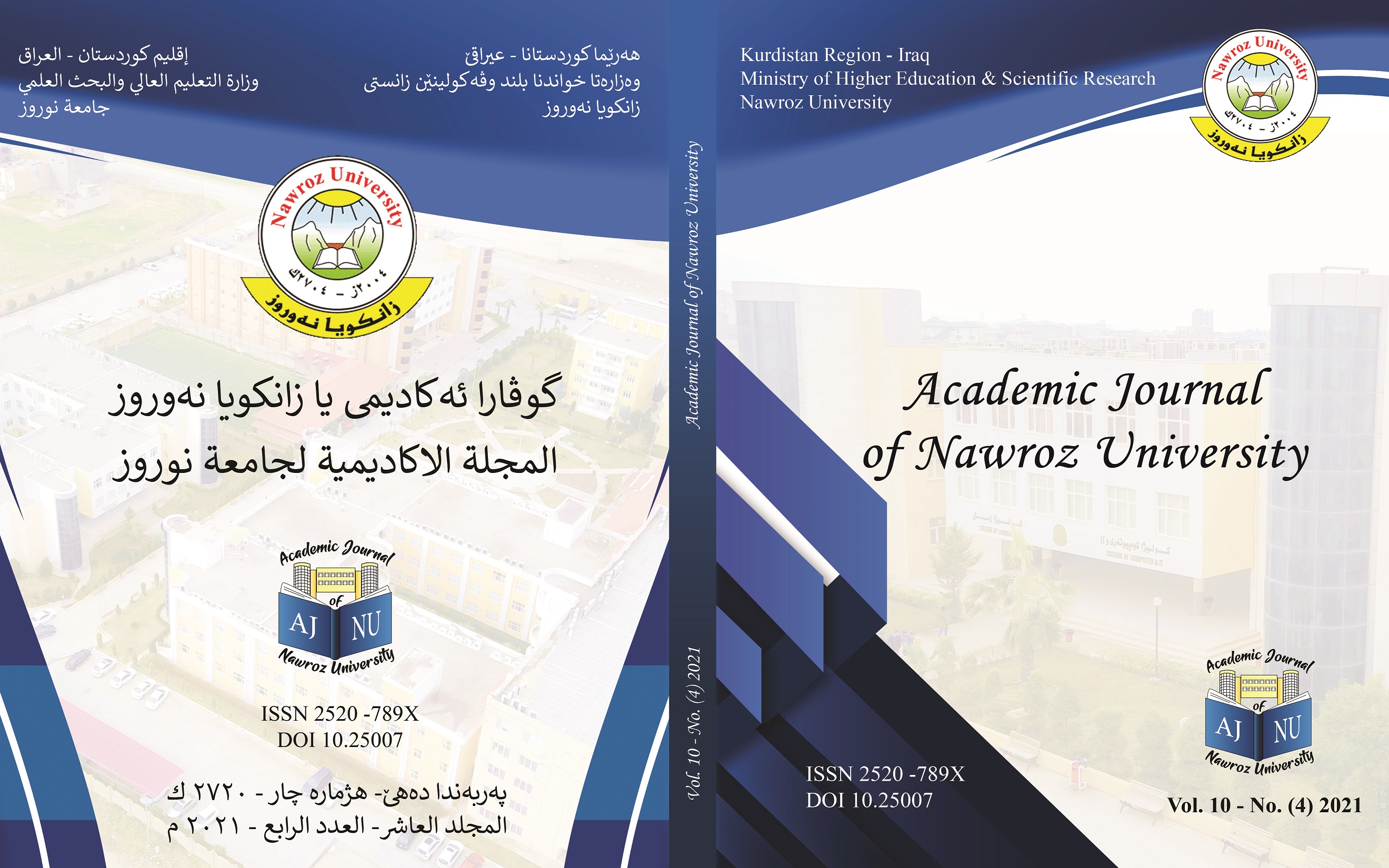Measuring the effect of military spending on the fixed capital formation of the Kingdom of Saudi Arabia for the period 1980-2018
DOI:
https://doi.org/10.25007/ajnu.v10n4a1314Abstract
The increase in the share of military expenditures to the gross domestic product of the Kingdom of Saudi Arabia during the past three decades has had negative effects on many economic and social variables, which have burdened its national economy with many burdens, represented in the decline of many economic and social indicators as a result of the lack of new investment opportunities, to show the effect of This directly affects the fixed capital formation, which burdened the Saudi economy with the burden of the opportunity cost. Accordingly, the research seeks to shed light on the reality of military spending in Saudi Arabia, focusing on the reasons and motives behind the increased spending based on the hypothesis that the increase in the share of military spending in the budget is due to the financial abundance derived from oil revenues. In the short and long run between military spending and the constant variable capital formation.
For the purpose of achieving the hypothesis of the research, it was relied on the co-integration methodology using the Autoregressive Distributed Lag cointegration technique (ARDL) to measure the effect of military spending on the fixed capital formation of the Kingdom of Saudi Arabia for the period (1980-2018), and the research came out with a set of conclusions, including proving the existence of Negative and moral effect between military spending and constant capital formation in the short and long run.
The research also found that the arms race that Saudi Arabia is waging has burdened the economy, especially in light of the state’s rentierism and its almost total dependence on oil revenues, which made it more vulnerable to shocks resulting from oil price fluctuations and economic and political transformations at the global level.
Downloads
References
التقارير والنشرات العربية والدولية
الامم المتحدة، تقرير الخبراء الحكوميين حول الصلة بين نزع السلاح والتنمية في السياق الدولي الراهن ، نيويورك، 2004
صندوق النقد الدولي، المملكة العربية السعودية معالجة التحديات الاقتصادية الناشئة للحفاظ على النمو، متوفر على الرابط الاتي: www.imf.org/mrdia/website/IMF/imported
الكتاب السنوي لمعهد ستوكهولم لدراسات السلام اعداد متفرقة للسنوات 1985-2019 متوفر على الرابط الاتي: https://www.sipri.org/yearbook/2019 و www.sipri.org/research/armament-and-disarmament/arms-and-military-expenditure/military-expenditure
النشرات الاحصائية لمؤسسة النقد السعودي اعداد مختلفة للاعوام 1980-2019 منشورة على الموقع الالكتروني.
http://www.sama.gov.sa/ar-sa/EconomicReports/Pages/YearlyStatistics.aspx
4البحوث والدوريات
أحمد, إبراهيم. (2006). أثر إجمالي التكوين الرأسمالي الثابت وعرض النقد على النشاط الإقتصادي. مجلة جامعة تشرين للبحوث والدراسات العلمية.
الخطيب ، فوزي، المومني ، رياض، 1990، الانفاق العسكري واثره على التنمية الاقتصادية في الاردن ، مجلة ابحات اليرموك سلسلة العلوم الانسانية والاجتماعية، المجلد 6 العدد 4.
عطية، محمود صالح، 2011، اسباب زيادة النفقات العامة بين الفكر التقليدي والفكر الحديت، مجلة ديالى، العدد 50.
كطان، جواد كاظم، 2009، أبعاد الأمن الوطني ،مجلة المستقبل العراقي، العدد 17.
4الكتب
الفارس، عبدالرزاق، 1993، السلاح والخبز، الإنفاق العسكري في الوطن العربي ، الطبعة الثالثة، بيروت، مركز دراسات الوحدة العربية .
عبدالعزيز، محمد نور، تجارب النمو والتنمية في العالم ،الطبعة الاولى ، دار العاصي للطباعة والنشر والتوزيع، بيروت.
محمد، شيخي، طرق الاقتصاد القياسي محاضرات وتطبيقات، 2012، الطبعة الاولى، دار الحامد للنشر والتوزيع ، عمان، الاردن.
.5المصادر الانكليزية
1 Researches
Chairil , Tangguh , 2013, Relationship between Military Expenditure and Economic Growth in ASEAN: Evidence from Indonesia, Journal of ASEAN Studies.
Chairil , Tangguh , 2013, Relationship between Military Expenditure and Economic Growth in ASEAN: Evidence from Indonesia, Journal of ASEAN Studies.
Chowdhury, A.R., 1991. Defense spending and economic growth. Journal of Conflict Resolu- tion, 35.
Collier, Paul, and Hoeffler, Anke 2009 Military expenditure in post-conflict societies, Economics of Governance, 7.
Daniel P. Hewitt Daniel P, 1991, Military Expenditure: International Comparison of Trends, IMF WORKINÍ; PAPER.
Gülbahar ÜÇLER, 2016, Testing the relationship between military spending and private investments: Evidence from Turkey, Theoretical and Applied Economics Volume XXIII (2016), No. 3(608), Autumn.
Hou, N., and Chen, B., 2014. Military Expenditure and Investment in OECD Countries: Revisited.
J. Paul Dunne & Nan Tian, 2013. " HYPERLINK "https://ideas.repec.org/a/epc/journl/v8y2013i1p5-11.html" Military expenditure and economic growth: A survey," HYPERLINK "https://ideas.repec.org/s/epc/journl.html" Economics of Peace and Security Journal, EPS Publishing, vol. 8(1).
M Ensar Yesilyurt & J Paul Elhorst,2017, Impacts of neighboring countries on military expenditures: A dynamic spatial panel approach, journal of Peace Research2017, Vol. 54(6)
MEYER Francois & SANUSI Abimbola ,2019 A CAUSALITY ANALYSIS OF THE RELATIONSHIPS BETWEEN GROSS FIXED CAPITAL FORMATION, ECONOMIC GROWTH AND EMPLOYMENT IN SOUTH AFRICA, STUDIA UNIVERSITATIS BABEȘ-BOLYAI OECONOMICA, VOLUME 64, ISSUE 1.
Peace Economics, Peace Science and Public Policy, Vol. 20, Issue 4.
Rahman , Taimur 2019, The Effect of Military Spending on Economic Growth in the Presence of Arms Trade: A Global Analysis https://papers.ssrn.com/sol3/papers.cfm?abstract_id=3401331
HYPERLINK "https://www.researchgate.net/profile/Rizgar_Abdlaziz" Rizgar Abdlkarim Abdlaziz, HYPERLINK "https://www.researchgate.net/scientific-contributions/NAM-Naseem-2147299886" N.A.M. Naseem& HYPERLINK "https://www.researchgate.net/profile/Ly_Slesman" Ly Slesman 2020, The Impact of Oil Price Shocks on the Military Expenditure of Selected MENA Oil Exporting Countries: Symmetric and Asymmetric Co-Integration Analysis, https://www.researchgate.net/publication
Ron P Smith, & J. Paul Dunne, 2019, , Military Expenditure Growth and Investment, Journal HYPERLINK "https://www.tandfonline.com/toc/gdpe20/current" Defence and Peace Economics Volume 3 Received.
HYPERLINK "https://www.sciencedirect.com/science/article/pii/0147596780900505"Ronald PSmith, 1980, Military expenditure and investment in OECD countries, 1954–1973, HYPERLINK "https://www.sciencedirect.com/science/journal/01475967"Journal of Comparative Economics HYPERLINK "https://www.sciencedirect.com/science/journal/01475967/4/1"Volume 4, Issue 1.
Saab , Bilal Y. 2014, THE GULF RISING Defense Industrialization in Saudi Arabia and the UAE, Brent Scowcroft Center on International Security at the Atlantic Council. https://www.files.ethz.ch/isn/182154/The_Gulf_Rising.pdf
Scheetz, T., 1991. The macroeconomic impact of defense expenditures: Some econometric evidence for Argentina, Chile, Paraguray and Peru. Defense Economics, 3.
HYPERLINK "javascript:;" Seyfettin Erdoğan, HYPERLINK "javascript:;" Emrah İsmail Çevik & HYPERLINK "javascript:;" Ayfer Gedikli 2020, Relationship between oil price volatility and military expenditures in GCC countries, HYPERLINK "https://link.springer.com/journal/11356" Environmental Science and Pollution Research volume 27.
Tangguh Chairil, Dedy S. Sinaga& Annisa I. Febrianti 2013, Relationship between Military Expenditure and Economic Growth in ASEAN: Evidence from Indonesia, Journal of ASEAN Studies, Vol. 1, No. 2.
Yildirim, Julide, and Sezgin, Selami (2005) Democracy and Military expenditure: A Cross-Country Evidence, Transition Studies Review, 12.
2 Books
Gujarati ,Damodar, 2005 Basic Econometrics,5Th Edition ,New York.
Kozhan , Roman (2009) "Financial econometrics - with Eviews",
Nkoro, Emeka and Kelvin, Aham , 2016, 2016Autoregressive Distributed Lag (ARDL) cointegration technique: application and interpretation, Journal of Statistical and Econometric Methods, vol.5, no.4
Pesaran , M. Hashem, 1997, An Autoregressive Distributed Lag Modelling Approach to Cointegration Analysis, Department of Applied Economics, University of Cambridge, England, First Version: ebruary, 1995, Revised: January, 1997.
Wooldridge, Jeffrey M, 2013 Econometrics , Fifth Edition, United States of America.
Downloads
Published
How to Cite
Issue
Section
License
Copyright (c) 2021 Souad A. Qasim, Wafaa S. Khidir

This work is licensed under a Creative Commons Attribution-NonCommercial-NoDerivatives 4.0 International License.
Authors retain copyright
The use of a Creative Commons License enables authors/editors to retain copyright to their work. Publications can be reused and redistributed as long as the original author is correctly attributed.
- Copyright
- The researcher(s), whether a single or joint research paper, must sell and transfer to the publisher (the Academic Journal of Nawroz University) through all the duration of the publication which starts from the date of entering this Agreement into force, the exclusive rights of the research paper/article. These rights include the translation, reuse of papers/articles, transmit or distribute, or use the material or parts(s) contained therein to be published in scientific, academic, technical, professional journals or any other periodicals including any other works derived from them, all over the world, in English and Arabic, whether in print or in electronic edition of such journals and periodicals in all types of media or formats now or that may exist in the future. Rights also include giving license (or granting permission) to a third party to use the materials and any other works derived from them and publish them in such journals and periodicals all over the world. Transfer right under this Agreement includes the right to modify such materials to be used with computer systems and software, or to reproduce or publish it in e-formats and also to incorporate them into retrieval systems.
- Reproduction, reference, transmission, distribution or any other use of the content, or any parts of the subjects included in that content in any manner permitted by this Agreement, must be accompanied by mentioning the source which is (the Academic Journal of Nawroz University) and the publisher in addition to the title of the article, the name of the author (or co-authors), journal’s name, volume or issue, publisher's copyright, and publication year.
- The Academic Journal of Nawroz University reserves all rights to publish research papers/articles issued under a “Creative Commons License (CC BY-NC-ND 4.0) which permits unrestricted use, distribution, and reproduction of the paper/article by any means, provided that the original work is correctly cited.
- Reservation of Rights
The researcher(s) preserves all intellectual property rights (except for the one transferred to the publisher under this Agreement).
- Researcher’s guarantee
The researcher(s) hereby guarantees that the content of the paper/article is original. It has been submitted only to the Academic Journal of Nawroz University and has not been previously published by any other party.
In the event that the paper/article is written jointly with other researchers, the researcher guarantees that he/she has informed the other co-authors about the terms of this agreement, as well as obtaining their signature or written permission to sign on their behalf.
The author further guarantees:
- The research paper/article does not contain any defamatory statements or illegal comments.
- The research paper/article does not violate other's rights (including but not limited to copyright, patent, and trademark rights).
This research paper/article does not contain any facts or instructions that could cause damages or harm to others, and publishing it does not lead to disclosure of any confidential information.





